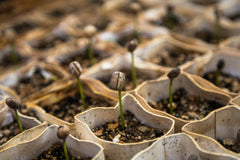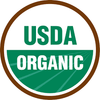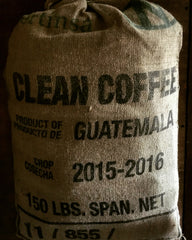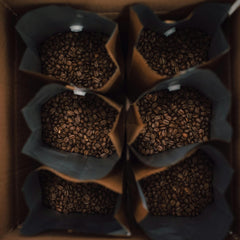When you pour that first-morning cup of coffee you’re probably just thinking about that delicious deep flavor and how it’s exactly what you need to kickstart your day. But do you ever think about what harm it could be causing, what it took to get it to you, or how it impacts the planet before you take that first sip?
Conventional coffee growing and processing is extremely harmful to the earth and farming communities. With the coffee industry projected to hit $182 billion by 2030, its impact on global economies, ecosystems, and communities will only get worse unless we shift to more environmentally friendly options.
Fortunately sustainable coffee supports biodiversity, natural resources, and fair treatment and wages for farmers and workers. And switching to sustainable coffee is easier than ever if you know what to look for.
1.Check the Growing Methods
One of the main factors of whether your coffee is sustainable is how the coffee is grown. Growing methods impact soil health, water quality, and ecosystem resilience.
Avoid Sun-Grown Coffee
Conventional Sun-grown coffee is grown in direct sunlight, in large, open fields without trees or shade-providing vegetation. Farmers use this method because it often has a higher yield and lower labor costs versus shade-grown methods, but those savings come at the expense of the environment.
Trees are cut down to clear land for sun-grown coffee disrupting wildlife habitats and our ecosystem. Without shade, the soil is dried out by the sun, leading to erosion and making it less fertile over time. To grow more coffee plants, farmers turn to synthetic pesticides and fertilizers, which pollute soil and water.
Choose Shade Grown Coffee
Shade-grown coffee, grown under tree canopies, is one of the most environmentally friendly coffee farming practices. This traditional method protects  biodiversity by providing habitats for various plants and animals and preserves native species.
biodiversity by providing habitats for various plants and animals and preserves native species.
Growing coffee in the shade enhances soil health and fertility by regulating temperatures and moisture levels, reducing erosion, and improving nutrient cycling. It also conserves water by minimizing evaporation and maintains water quality in rivers and streams by slowing rainwater runoff that may carry sediments and pollutants to water sources.
2. Look for Sustainable Farming Practices
Sustainable farming methods minimize environmental impact, promote biodiversity, and ensure the well-being of farmers and communities.
Resist Conventional Coffee Growers
Conventional coffee farming relies heavily on synthetic pesticides and fertilizers, which can harm ecosystems and aquatic life by seeping into soil and waterways. These chemicals also endanger farm workers' health and nearby communities, causing respiratory issues, skin irritations, and long-term health problems.
Pesticides used in conventional coffee farming can remain on the coffee beans even after processing and can be ingested by consumers. Chronic exposure to these chemicals over time can lead to neurological disorders, hormonal imbalances, and even certain types of cancer. Choosing organic or sustainably grown coffee can help minimize exposure to harmful pesticides and give you a longer, healthier life.
Support Organic Coffee Farms

Alternatively, organic coffee supports soil health, biodiversity, and water conservation by not relying on synthetic pesticides, herbicides, or fertilizers. This method focuses on composting, crop rotation, and natural pest control, to enrich the soil with essential nutrients and microorganisms. By avoiding harmful chemicals, organic farms provide habitats for various plants and animals, creating a healthier, more balanced environment.
Coffee beans grown with organic farming practices are naturally rich in nutrients and antioxidants and won’t put us at risk of ingesting harmful chemicals or toxic mold. By choosing organic coffee, you can enjoy a healthier brew and support environmentally sustainable farming practices that benefit both people and the planet.
3. Understand Sustainable Coffee Certifications
One of the easiest ways to find sustainable coffee is by looking for third-party certifications and specific terms on the label. Certifications like Rainforest Alliance, Fair Trade, and Bird Friendly indicate that the coffee meets certain sustainability standards. These organizations have done the work for you and make it easier to find sustainable coffee options.
Shade Grown Coffee

Shade-grown coffee is known for its environmental benefits, providing habitats for various plants and animals while enhancing soil health and water conservation. To find shade-grown coffee, look for the shade-grown seal on your label or other certifications like Rainforest Alliance or Bird Friendly options.
The shade-grown certification means that your coffee is grown under a thick canopy of trees and has passed tests that show diverse plant and insect populations.
Rainforest Alliance Certified

The Rainforest Alliance certification ensures that coffee is shade-grown and harvested sustainably, with a focus on protecting ecosystems and supporting coffee-growing communities. Farms certified by the Rainforest Alliance follow strict criteria regarding sustainable farming practices, including preserving biodiversity, soil health, and water resources.
This certification also includes the social and economic aspects of coffee production. Certified farms are required to uphold fair labor practices like fair wages and safe working conditions.
Bird Friendly Coffee

Coffee cultivation often involves removing natural vegetation to make way for coffee plantations. This habitat destruction can harm bird populations by reducing food sources and making them more vulnerable to predators.
Organic Coffee

Organic growing methods minimize the environmental impact of coffee farms by preventing soil and water contamination, reducing air pollution, and preserving biodiversity. These practices also promote the health of ecosystems by supporting beneficial insects, microorganisms, and wildlife populations.
Look for labels like USDA Organic to ensure your coffee is produced sustainably. This certification includes requirements for natural pest control, land management practices, and record-keeping to ensure transparency and accountability throughout the production process.
Biodynamic Certified

Organic and biodynamic farming methods both prioritize sustainable agriculture, but follow different methodologies and philosophies. Biodynamic farming has a more holistic perspective, treating the farm as a self-sustaining ecosystem where soil health, plant growth, and environmental sustainability are interconnected. This method often follows lunar cycles to determine when to plant and harvest and relies on local materials whenever possible.
The popularity of this method is steadily increasing as more farmers recognize its effectiveness in promoting ecological balance and resilience. To ensure that your coffee aligns with these environmentally conscious practices, look for the Demeter certification on the label, indicating rigorous biodynamic farming standards.
Fair Trade Certified

While fair trade practices may seem more like a social justice issue than an environmental one, they have substantial environmental impacts. Fairtrade certification ensures farmers who grow and process coffee receive a fair wage for their work and product. When farmers aren't paid a fair wage, they may be forced to use unsustainable farming practices and chemicals that can harm the environment.
Fair trade practices in the coffee industry also incentivize eco-friendly farming practices and advocate for local communities. To support these initiatives, look for certifications like Fair Trade, Rainforest Alliance, or USDA Organic on coffee packaging.
Regenerative Organic Certified

Check for the ROC certification on your coffee label. By choosing ROC-certified coffee, consumers can support agricultural systems that produce high-quality coffee and contribute to the restoration and resilience of ecosystems and communities.
4. Source from More Local Origins

Coffee is grown primarily near the equator along the “bean belt” which has ideal coffee growing conditions. This means your coffee may have to travel a long distance by land, sea, and air to make its way from farms, to processing facilities, to markets, and finally to you. Each part of the journey contributes to carbon emissions which leads to climate change.
Always check your label to understand how far away your coffee is grown. If you’re in the US, coffee from Central or South America has a much shorter journey than beans from Sumatra. Choosing locally sourced coffee, or beans from closer regions, reduces its environmental impact.
5. Choose Coffee with Sustainable Packaging

About 30% of the total waste in the US is from packaging. Traditional coffee packaging, like single-use plastic bags, often ends up in landfills where they decompose slowly and release harmful chemicals. Even plastic containers considered recyclable may be harmful as only about 9% of plastic waste is actually recycled.
Fortunately, many coffee brands are adopting eco-friendly alternatives such as compostable or biodegradable materials, recyclable options, or refillable and reusable containers. Supporting brands that prioritize eco-friendly materials encourages the industry to shift towards more sustainable packaging, reduces waste in landfills, and minimizes the environmental impact of your coffee consumption.
6. Opt for Carbon Neutral Shipping

By choosing carbon-neutral shipping when buying coffee online, you're offsetting carbon emissions created during transportation. The environmental cost of delivery is balanced by supporting projects that reduce or capture carbon dioxide elsewhere like wind farms or reforestation. Going carbon neutral means you’re joining the fight against climate change and encouraging eco-friendly pra
ctices in the coffee supply chain.
7. Consider Buying in Bulk

Buying coffee in bulk helps the environment by reducing the amount of packaging used. When you purchase larger quantities of coffee at once, you minimize the need for individual packaging for each purchase and reduce overall waste. This reduction in packaging helps conserve resources, decreases energy used in production, and keeps thousands of pounds of waste out of our landfills.
8. Make Coffee At Home
If you're brewing coffee at home, you can make an even bigger impact by incorporating eco-friendly practices and accessories into your routine. Using a reusable coffee cup eliminates the need for disposable cups, which often end up in landfills or pollute oceans. Opting for reusable filters made from materials like stainless steel or cloth reduces the amount of paper waste generated from traditional paper filters. And choosing a reusable stirrer instead of disposable plastic stirrers minimizes plastic pollution.
Beyond reusable accessories, there are other ways to reduce coffee-related waste at home. Composting coffee grounds instead of throwing them away can divert organic waste from landfills and create nutrient-rich compost for gardens or plants. Properly storing coffee beans in airtight containers helps maintain freshness and reduces the need for excessive packaging or single-use bags.
Your Daily Choice Matters
Our morning coffee choices can have a significant impact on the world around us. While it's easy to keep reaching for the same bag of beans on the grocery store shelf, swapping out your usual brew for a sustainable option can make a difference for the environment, farmers, and wildlife.
So, next time you fill your cup, remember that your choice can create positive change, one sip at a time.

Interested in making a change to a more sustainable brew? Check out our sustainable collection or try the Peak State Coffee Variety Pack and know you’re making a difference at a global level!

